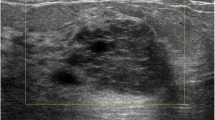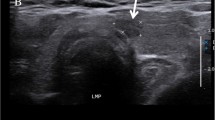Abstract
Background
Invasive micropapillary carcinoma of the breast (IMPC) has been considered to have no specific image finding. The purpose of this study was to correlate the ultrasonographic findings of IMPC, especially internal echogenicity, with histological findings and to discuss the histological factor that influenced the internal echogenicity.
Methods
Six patients who had undergone surgery at our institute between October 2005 and February 2010 and had been subsequently diagnosed with IMPC were enrolled in this study. Internal echogenicities were correlated with the presence or absence of the central lumens within tumor cell clusters, and with the size of the spaces around these tumor cells.
Results
The internal echogenicities of three IMPCs were isoechoic compared with subcutaneous fat tissue, and those of the other three IMPCs were hypoechoic. All three isoechoic IMPCs had central lumens, while no central lumen was seen in the three hypoechoic IMPCs. There was no relation between the size of spaces around the tumor cells and internal echogenicity. All tumors showed either posterior enhancement or no posterior acoustic feature.
Conclusions
Half of the IMPCs in our study showed isoechogenicity on ultrasonography. The existence of a central lumen in the tumor cell clusters might have contributed to relatively high internal echogenicity of these IMPCs.




Similar content being viewed by others
References
Gunhan-Blgen I, Zekioglu O, Ustun EE, Memis A, Erhan Y. Invasive micropapillary carcinoma of the breast: clinical, mammographic, and sonographic findings with histopathologic correlation. AJR Am J Roentgenol. 2002;179:927–31.
Adrada B, Arribas E, Gilcease M, Yang WT. Invasive micropapillary carcinoma of the breast: mammographic, sonographic, and MRI features. AJR Am J Roentgenol. 2009;193:W58–63.
Siriaunkgul S, Tavassoli FA. Invasive micropapillary carcinoma of the breast. Mod Pathol. 1993;6:660–2.
Ellis IO, Cornelisse CJ, Schnitt SJ, Sasco AJ, Sastre-Garau X, Kaaks R, et al. Tumours of the breast. In: Tavassoli FA, Devilee P, editors. World Health Organization classification of tumours, pathology and genetics of tumours of the breast and female genital organs. Lyon: IARC Press; 2003. p. 9–112.
Rosen PP. Invasive micropapillary carcinoma. In: Rosen PP, editor. Rosen’s breast pathology. 2nd ed. Philadelphia: Lippincott Williams & Wilkins; 2001. p. 561–4.
Kuroda H, Sakamoto G, Ohnisi K, Itoyama S. Clinical and pathologic features of invasive micropapillary carcinoma. Breast Cancer. 2004;11:169–74.
Akiyama F, Sakamoto G, Inai K, Kurosumi M, Tsuchiya S, Tsuda H. Histologic classification. In: The Japanese Breast Cancer Society, editor. General Rules for Clinical and Pathological Recording of Breast Cancer. 16th ed. Tokyo: Kanehara & Co., Ltd.; 2008. p. 18–59. (in Japanese).
Lam WW, Chu WC, Tse GM, Ma TK. Sonographic appearance of mucinous carcinoma of the breast. AJR Am J Roentgenol. 2004;182:1069–74.
Memis A, Ozdemir N, Parildar M, Ustun EE, Erhan Y. Mucinous (colloid) breast carcinoma: mammographic and US features with histologic correlation. Eur J Radiol. 2000;35:39–43.
Chopra S, Evans AJ, Pinder SE, Yeoman LJ, Ellis IO, Elston CW, et al. Pure mucinous breast cancer-mammographic and ultrasound findings. Clin Radiol. 1996;51:421–4.
Sakuma H. Genkyoku-gata Shuryu. In: Sakuma H, Obane N, editors. Nyubo Chouonpa Jissen manual. Tokyo: Ishiyaku Publishers, Inc.; 2005. p. 62–9. (in Japanese).
Kamitani K, Ono M, Toyoshima S, Mitsuyama S, Anan K, Ikeda Y. Isoechoic axillary lymph node metastases of mucinous carcinoma of the breast: a case report. Breast Cancer. 2006;13:382–5.
Acs G, Paragh G, Chuang ST, Laronga C, Zhang PJ. The presence of micropapillary features and retraction artifact in core needle biopsy material predicts lymph node metastasis in breast carcinoma. Am J Surg Pathol. 2009;33:202–10.
Author information
Authors and Affiliations
Corresponding author
About this article
Cite this article
Kamitani, K., Kamitani, T., Ono, M. et al. Ultrasonographic findings of invasive micropapillary carcinoma of the breast: correlation between internal echogenicity and histological findings. Breast Cancer 19, 349–352 (2012). https://doi.org/10.1007/s12282-011-0293-2
Received:
Accepted:
Published:
Issue Date:
DOI: https://doi.org/10.1007/s12282-011-0293-2




